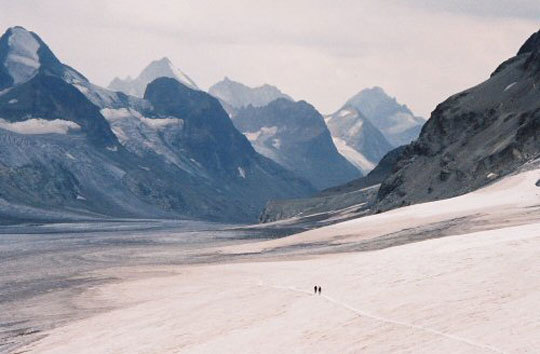
Skiers traversing the Haute Route, Switzerland. In May, Stephan Brosse and Lionel Bonnel completed a new–longer and more grueling–variation of the classic traverse from Chamonix, France to Zermatt, Switzerland. They skied the 120 miles and 28,220 feet of elevation gain in twenty-one hours and eleven minutes. The standard route usually takes a fit skier six to seven days to complete. [Photo] . Seabhcan
At 1 a.m. on May 2, 2008, French Alpine Club ski mountaineers Stephan Brosse, Lionel Bonnel and Laurent Fabre left from a church in downtown Chamonix to ski the famed Haute Route to Zermatt. Their objective was to cover the 28,220 feet of elevation gain and 120-mile, partially glaciated traverse in fewer than twenty-four hours, without using any technical assistance. Loaded with the appropriate gear, the trio ran to the Argentiere Glacier, where the Haute Route normally begins. Twenty-one hours and eleven minutes later, Brosse and Bonnel were celebrating success in front of a church in Zermatt. Overcome with exhaustion, Fabre had abandoned the challenge that afternoon.
First successfully completed on skis in 1911, the Haute Route is likely the most famed ski traverse in the world. It usually takes six to seven days for skiers to cross from Chamonix to Zermatt, finding shelter in mountain huts along the way. Seventy-eight years after the first crossing, French alpinist Denis Pivot did a solo traverse of the standard Haute Route in nineteen hours and twenty-four minutes. Unlike the 2008 record, though, Pivot left from the top of the Grands Montets cable car, the start of the classic itinerary (Grand Montets Pass, Col du Chardonnet, Champex, car commute to Bourg St Pierre, Col du Sonadon, Otemma Glacier, Col du Petit Mont Colon, Col de l’Eveque, Col du Mont Brule, Col de Valpelline, Zermatt). In 2006, Pivot broke his own record by one hour and twenty-four minutes, bringing it down to 17:38. Both times he used technical assistance for forty-five minutes, transitioning by car to Bourg St. Pierre.
Brosse and Bonnel’s traverse required no technical assistance and added more than 15 miles of travel and 7,000 feet of elevation gain.
Pivot’s solo record-setting traverses inspired Brosse, but this spring the trio wanted to eliminate gaps in the traverse, requiring the longer, more technical route (Chamonix, Argentiere, Col du Chardonnet, Col de la Grande Lui, A Neuve Village, La Basset, Bourg St Pierre, Col du Sonadon, Otemma Glacier, Col du Petit Mont Colon, Col de l’Eveque, Col du Mont Brule, Col de Valpelline, Zermatt). “I thought that it would be better ethic to start from Chamonix itself,” Brosse said, “and not use any means of transportation other than skis up high or walking in snow-barren areas.”
They nearly claimed defeat on three occasions. Early on, between the col du Chardonnet and that of the Grande Lui, bad weather and fresh snow forced the team to break trail, slowing their pace. When Fabre gave in to fatigue before the Col du Sonadon, Brosse and Blonnel questioned if they should descend with him. Though they pushed on, the next difficult section tested their physical and mental limits: “The Ottema Glacier, located on the Swiss and Italian border, is 7.5 miles long for only 3,300′ elevation gain. We had planned on climbing it in less than three hours, not taking into account the toll that the blazing heat would take on us. While taking a break at 4:30 p.m., we realized that over the past hour and a half, we had only gained 800′ in elevation. Knowing that we still had to gain 2,500′ on this never-ending glacier, topped by yet another 2,500′ in elevation over three passes before enjoying the descent to Zermatt, we hit a psychological wall. Our arrival time prognostics were consequently rather pessimistic. We had to remind ourselves that our primary objective was to make it to Zermatt in a non-stop push. Timing then became a secondary priority.” The pair nevertheless arrived in Zermatt with about three hours to spare on their twenty-four-hour deadline.
When asked why so few people have attempted this traverse in one day, Pivot said that many criteria are vital to success: “You need to be in top physical and psychological shape, be acclimated, have good weather conditions, benefit from great snow conditions–the snow should be low enough in altitude so that you don’t have to carry your skis too much, yet it needs to be already transformed to avoid breaking trail–and then make yourself available when all these conditions are gathered.
“Brosse and Blonnel started their chronometers in Chamonix,” Pivot noted, “while I started mine atop the Grands Montets cable car. It would therefore be inaccurate to say my record is 3:33 faster than theirs,” Pivot explains. “Our record times are hard to compare, because we did not travel the same routes–our itineraries are only identical from Bourg St. Pierre. The elevation gains and distances are different, but moreover, one was done solo and the other one as a team. On such glaciated terrain and at an average altitude of 10,000′, the commitment is incomparable. You can only rely on yourself if caught in an avalanche, fall in a crevasse, hurt yourself or have to break trail. I only started coming across other skiers fourteen hours into the effort. On such long hauls, the psyche is essential: when going solo though, no one can comfort you in times of doubts or second guessing.”
Nevertheless, both records offer new ways to celebrate and experience the Haute Route. Pivot salutes their effort: “It’s a magnificent record, which symbolically connects the two capitals of alpinism with no technical assistance. They imagined a non-stop traverse and then lived it. A record is just that: making a dream come true and experiencing an inner adventure.”